IN THIS ISSUE
- Spot a tegu, tell DNR
- Meet ABAC's Dr. Lane
- Bluebird migration mystery
- Sea turtle nesting vs. Dorian
- 105-pound alligator snapper
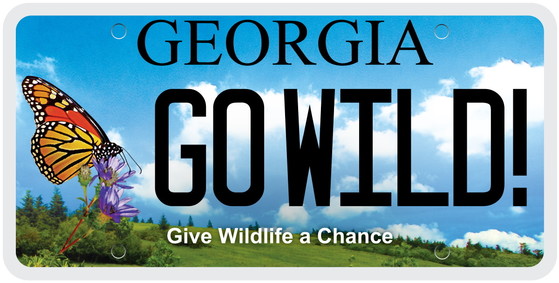 Looking for an easy way to help conserve wildlife in Georgia?
Add DNR’s new pollinator plate to your vehicle.
Now available in county tag offices, these colorful tags sport a monarch butterfly and a Georgia aster. Both native species are conservation priorities in Georgia’s State Wildlife Action Plan.
The pollinator plate replaces the ruby-throated hummingbird design.
But like its predecessor, the new tag provides critical support for restoring and maintaining populations of Georgia wildlife not legally fished for or hunted, plus rare plants and natural habitats.
High visibility and high impact. This plate packs a pretty powerful punch.
Top
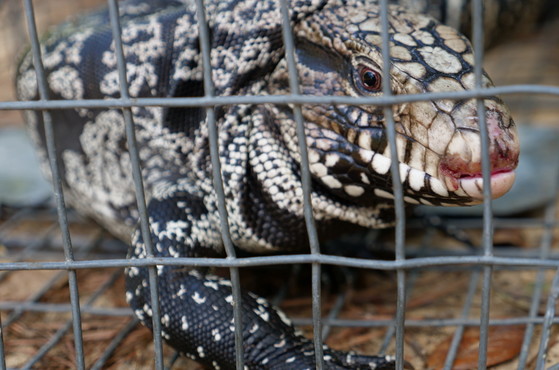 Argentine black and white tegu trapped in Toombs County (Denise Shepherd/DNR)
Georgia’s wildlife need you.
A campaign to combat tegus in Toombs and Tattnall counties is making a last push for the public’s help before the big, invasive lizards go into brumation for winter.
DNR and Georgia Southern University reached out to residents and media last week. The take-homes: Tegus don’t belong here. Report any you see – alive or dead.
Argentine black and white tegus have established a population here from released or escaped animals. Most sightings are in eastern Toombs and western Tattnall.
While popular in the pet trade, these South American lizards spell trouble for native wildlife. Argentine black and white tegus grow up to 4 feet long and 15 pounds, and eat everything from rats and skinks to blackberries and beetles. But they favor eggs. The eggs of ground-nesting birds, such as quail and turkeys, and gopher tortoises, our state reptile, are subject to predation. Chicken eggs are another draw.
With support from the U.S. Geological Survey and DNR, Georgia Southern is trapping tegus. Nine have been collected. Nearly 100 traps are being monitored.
Reports by residents can hone that trapping effort and help scientists better understand the abundance and distribution of tegus in the area. Early detection and a rapid response are keys to preventing the spread and impact of invasive species.
To report tegus, take a photo (if possible), note the location and log the sighting at www.gainvasives.org/tegus or by contacting DNR at (478) 994-1438 or gainvasives@dnr.ga.gov.
Note that tegus in the wild can be trapped or killed in a humane fashion and in accordance with local ordinances. As a non-native species, they are not protected by Georgia wildlife laws or regulations.
Top
 ABAC's Dr. Vanessa Lane marks a beetle trapped at Alapaha River WMA. (Josiah Lavender/DNR)
PROFESSOR'S FOCUS VARIES FROM BIRDS TO BEETLES
On a sweltering day in May, Dr. Vanessa Lane is on her hands and knees sifting the sand around a rotting dead rat in a 5-gallon bucket on Alapaha River Wildlife Management Area.
Why? Because the burying beetles Lane is searching for “could be anywhere” in the inch-deep sand, she says, occasionally flipping her pony tail to keep it from dipping into the bucket. “They try to bury the carcass so they can have it to themselves.”
Welcome to Lane’s wide world of wildlife. The Abraham Baldwin Agricultural College associate professor ranges from teaching students wildlife ecology to leading talks to help people be less fearful of snakes. Her background is in birds. But she has eagerly branched into forestry, botany and even entomology.
The insects are a hobby, Lane says with a grin. And as with most hobbies, this one has a cost.
Continuing a project started by students, each month for three years Lane has checked beetle traps at Alapaha WMA daily – five consecutive days a month. She brings the bait (dead Norway rats), sets the pit-fall traps (buckets buried at ground-level with open mouths covered in chicken wire) and documents what shows up.
Catches vary from rainbow scarab beetles to Nicrophorus pustulatus, a carrion beetle that feeds on snake eggs and rates rare at Alapaha.
“I love it when I find pustulatus!” Lane laughs.
 A Carolina burying beetle, not uncommon at Alapaha (Josiah Lavender/DNR)
The status of Silphid beetles, a family that includes burying and carrion beetles, is largely a mystery in Georgia. Yet these creatures are critical. The American burying beetle is no longer found in that state and is federally listed as endangered. Questions abound, such as is land management affecting Silphid species here.
“We’d be up to our ears in dead things without 'decomposers,'" Lane says. "These beetles are one of the largest.”
The interest springs from the same source that prompted Lane, as a child turkey hunting with her dad, to wonder about a songbird neither could identify. That inquisitiveness and a love of the outdoors led the New York native to a conservation career in the South helping others understand and appreciate wildlife.
She plans to continue the beetle survey into 2022.
“It will be neat to see what happens after five years. Then I’ll have to get another pet project.”
Top
 One of the faster burrow obligate commensals: a gopher tortoise burrow robber fly (Giff Beaton)
By DIRK J. STEVENSON
Lying on the large apron of a gopher tortoise burrow, my head resting on the sand, I’m straining to extend my arm and a homemade pooper scooper as deep into the tunnel as I can.
At dawn, the humidity is near 100 percent. The plants of this “sugar-sand” sandhill – gopher apple, woody goldenrod, prickly pear and aromatic scarlet basil – are damp with condensation. After sampling seven burrows with no success, I am dripping with sweat, covered in sand and questioning my sanity.
Then, at my eighth burrow, I hit pay dirt. My scooper brings back several wads of fresh tortoise dung.
I eagerly pick through the tight packets of dried vegetation – “field cigars” to some tortoise scholars.
And with a rush of adrenalin rush, I find what I’m looking for: three beetle species found worldwide only in gopher tortoise burrows. …
Learn about tortoise burrow “obligate commensals” in Dirk’s two posts on the Wildlife Resources Division blog -- “Down the tortoise hole” and "Ties that bind."
Top
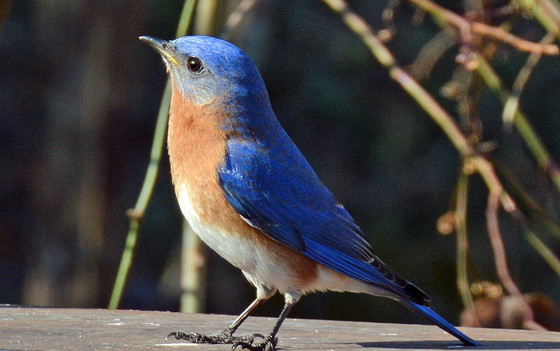 Eastern bluebird (Terry W. Johnson)
By TERRY W. JOHNSON
The eastern bluebird is one of our most beloved birds, and one of our most stunning in looks. But behind that beauty is a migratory behavior that is truly perplexing.
Although common in Georgia throughout the year, bluebirds are partial migrants. Some migrate; some don’t.
But sorting out which do – and even identifying the migration routes used – is where it gets complicated. …
Read Terry’s column for more on what we know or don't about bluebird migration.
Terry W. Johnson is a retired DNR program manager and executive director of TERN, the Wildlife Conservation Section’s friends group. Check out past columns, his Backyard Wildlife Connection blog and his book “A Journey of Discovery: Monroe County Outdoors.” (Permission is required to reprint this column.)
Top
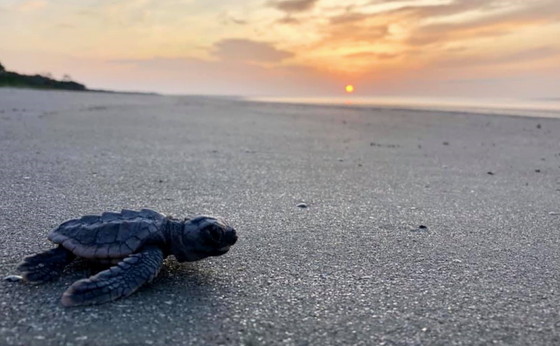 Loggerhead hatchling (Caleigh Quick/DNR)
Sea turtle nests on Georgia beaches took a hit from Hurricane Dorian. But Nature wasn’t caught off guard, and loggerheads – the state’s primary marine turtle species – continued their recovery, thanks to a record nesting season.
DNR Sea Turtle Program Coordinator Mark Dodd said about 20 percent of nests were “still in the ground” when the hurricane hit this month. About three-quarters were either destroyed or so inundated that poor hatching success is expected.
The good news: With 3,928 loggerhead nests laid since April – the most since comprehensive surveys began in 1989 – an estimated 240,000 hatchlings had emerged before Dorian arrived.
“We have put a lot of hatchlings in the water” this season, Dodd said.
Sea turtles’ reproductive “strategy” also accounts for hurricanes and other threats, the senior wildlife biologist explained. While loggerhead females nest only every two to three years, when they do, they lay as many as six clutches throughout that season. The totals and timing increase the odds that some hatchlings survive.
The Georgia Sea Turtle Cooperative, a DNR-led network of agencies, nonprofits and volunteers who monitor nesting, also factors in tropical storms. A higher percentage of late-season nests are relocated higher on the beach, where there’s less risk from storm surge or extreme tides, Dodd said.
The nesting trend for loggerheads, a threatened species, is increasing at an average rate of 3 percent a year. About 80 nests are still incubating on Georgia’s coast.
Top
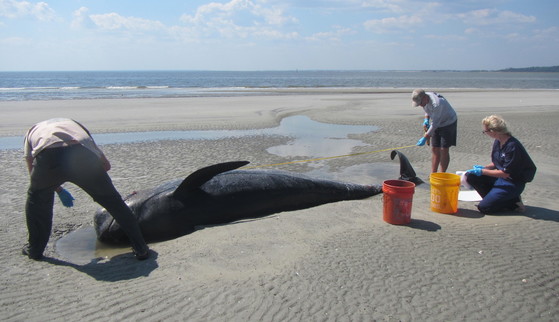 Measuring a dead pilot whale on St. Catherines (DNR/stranding response conducted under a stranding agreement between NMFS and DNR under the authority of the MMPA)
About 26 short-finned pilot whales stranded on or near St. Catherines Island this week, leaving 15 dead in Georgia’s second mass stranding this year ("Something I never expected," July 26). Although why the whales beached themselves isn't known, necropsies might provide clues and scientists note that short-finned pilot whales are the most common marine mammal species to mass strand in the southeastern U.S. Report stranded marine mammals: 800-2-SAVE-ME (800-272-8363) or 877-WHALE HELP (877-942-5343).
North America has lost as much as a third of its birds – an estimated 2.9 billion – since 1970, according to a new report in the journal Science. This net loss involves hundreds of species and widespread population declines, signaling “an overlooked biological crisis,” according to the study’s authors.
The number of endangered Canby's dropwort plants has grown by about 150 percent in a cypress savanna being restored at Big Dukes Pond Wildlife Management Area near Millen. Meanwhile, a Georgia census of endangered Tennessee yellow-eyed grass found that while some populations have disappeared, one had as many as 70,000 flowering spikes, the largest known site for this plant.
Top
 Beach vitex, an invasive species (Leslie J. Mehrhoff/University of Connecticut)
Beach vitex, dubbed “kudzu of the coast,” was recently removed from two sites in the dunes on Sea Island. This species originally imported from Japan and Korea grows fast, crowds out native plants such as sea oats and can even destroy nesting habitat for sea turtles. Watch.
Another dead North Atlantic right whale has been found, the ninth this year off the Canadian/U.S. coast. The male nicknamed Snake Eyes was seen last month entangled in commercial fishing gear in the Gulf of St. Lawrence, then its carcass turned up off Long Island, N.Y., this week.
Georgia Wild is informative, easy to read and even motivating, according to respondents in an annual reader survey. Asked about the impact of the newsletter, 83 percent said they had been spurred to learn more about a wildlife species or issue and more than 25 percent to financially support wildlife conservation.
Next steps in salvaging the 656-foot-long car carrier that capsized in St. Simons Sound on Sept. 8 include removing fuel from the vessel. Meanwhile, inspection teams and DNR staff are checking shorelines for leaked oil and other contaminants. Also, some 5,300 feet of absorbent boom have been deployed around “bird island,” a dredge spoil island created for nesting sea- and shorebirds. Report signs of oil or other contamination to 800-424-8802. Receive project updates.
Top
Thirty years after two Bay of Fundy sites became Canada’s first Western Hemisphere Shorebird Reserve Network site, that designation of critical shorebird habitat has been almost doubled in size. The upgrade to a Landscape of Hemispheric Importance, led by Nature Conservancy of Canada, now covers all four major bays in the Upper Bay of Fundy.
Top
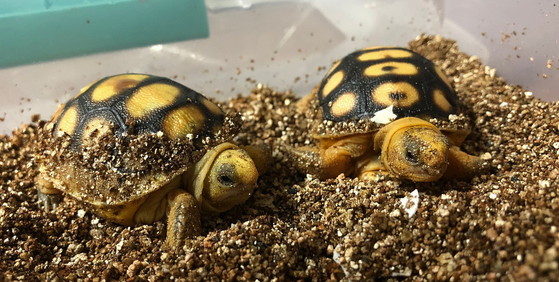 Tortoise hatchlings head-started at Warm Springs (Jessica Radich/USFWS)
Warm Springs National Fish Hatchery has welcomed more gopher tortoise hatchlings (above), raised from eggs and destined for release after being “head-started” to boost their odds of surviving. On the other end of that tortoise timeline, DNR’s Hal Massie photographed an old, one-eyed gopher (below) at Sandhills West Wildlife Management Area, its many years shown by a well-worn shell.
 A senior tortoise at Sandhills West WMA (Hal Massie/DNR)
While monitoring sea turtle nests on Ossabaw Island beaches this summer, DNR's Breanna Sorg and Caleigh Quick found 247 discarded balloons ... 247. Considering that sea turtles sometimes eat balloons, mistaking them for jellyfish, and that balloon ribbon can entangle birds and other wildlife, the moral to this story is clear: Don't release balloons. News coverage.
Names in the news: DNR’s Dr. J. Mincy Moffett Jr. discussed the Georgia Plant Conservation Alliance -- its importance in Georgia and the need for similar organizations in other states -- with a national committee of state transportation department natural resource and ecology staff. The conference call followed a Federal Highway Administration award recognizing Georgia DOT’s partnership with the plant network ("Alliance lands another honor," Aug. 27). Senior botanist Lisa Kruse co-authored a paper on genetic diversity involving Canby's dropwort. Published in Nature Areas Journal, the research delves into analysis that could help establish and add to populations of the endangered plant. Remember the Big Turtle Year, which included searching for some species in Georgia? Leaders George Heinrich and Timothy Walsh have detailed their adventure in The Tortoise.
UPCOMING
Sept. 28 – National Hunting and Fishing Day (free fishing -- no license required -- for Georgia residents)
Sept. 28 – DNR Hunt and Learn on squirrel hunting, Camp John Hope, Fort Valley. Others include: Oct. 12 (squirrel), Lanahassee Creek WMA, Preston; Oct. 25-27 (deer), Chattahoochee Fall Line WMA, Box Springs; Nov. 9 (quail), Falling Feathers at Whitaker Farm, Harlem; Nov. 12-14 (deer), Clybel WMA, Mansfield. Full details and schedule.
Sept. 29 – Monarch butterfly arts and crafts and release, starting at 1:30 p.m., Panola Mountain State Park, Stockbridge
Oct. 5 – CoastFest 2019, 10 a.m.-4 p.m., Mary Ross Waterfront Park, Brunswick
Oct. 26 – Environmental Alliance of Georgia Outdoor Learning Symposium, Chattahoochee Hills Charter School, Chattahoochee Hills
Nov. 1-3 – Becoming an Outdoors-woman workshop, Charlie Elliott Wildlife Center, Mansfield
March 2-6 – Southeastern Partners in Plant Conservation symposium and workshop, Southeastern Center for Conservation, Atlanta Botanical Garden
WHAT YOU MISSED ...
In the previous Georgia Wild:
– Remembering a revered botanist
– How to band 2,000 terns, and why
– Plant network lands another award
– Eva Persons' impact on conservation
Top
(+audio) "Researchers keep tabs on rare Georgia fish," WABE-FM (90.1, Atlanta)
(+video) "Georgia Southern trapping tegus," WJCL-TV (Ch. 22, Savannah)
"Georgia Southern Biological Sciences targets invasive species," The George-Anne
(+video) "Dorian damage minimal to turtle nests," WTOC-TV (Ch. 11, Savannah)
"Bipartisan right whale legislation introduced in Senate," The Brunswick News
"Williams describes far reach of state DNR," The Brunswick News
(+audio) "Georgia's first pollinator count will census bees, butterflies," WABE-FM (90.1, Atlanta)
"Study: U.S., Canada have lost 2.9 billion birds since 1970," CNN
"Burning away tick-borne diseases," The Orianne Society
"Diamondback terrapin, interrupted," Conserving the Nature of the Northeast
"Save an endangered beetle that exhibits parental care," Savannah Morning News
"Two women battle plastic plague on Ossabaw," WTGS-TV (Ch. 28, Savannah)
Top
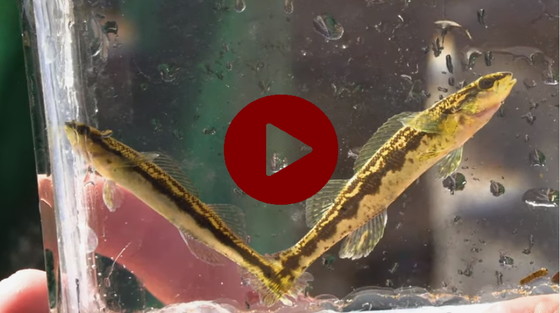 Goldline darters (Tennessee Aquarium)
VIDEO AND AUDIO
“Georgia-bound looking for imperiled goldline darters,” Tennessee Aquarium
“Georgia Wild: lizards,” DNR
Painting a right whale for National Geographic, Joe McKendry
“Camp TALON 2019,” DNR
Weather radar picks up bird migration, WSB-TV (Ch. 2, Atlanta)
(audio) “What kind of music is bird song?” BirdNote
Top
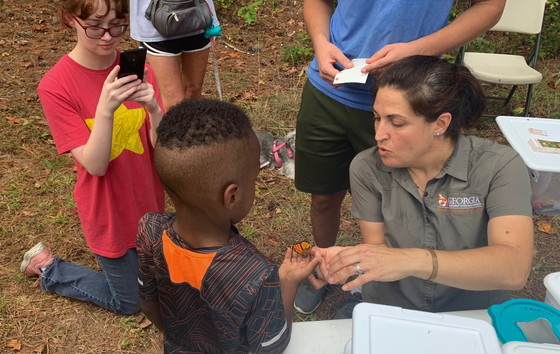 DNR's Anna Yellin helps a child release a monarch at Hard Labor Creek. (Dan Shulimson)
Taking it to the field: DNR’s Anna Yellin (above) tagged and released monarch butterflies with the help of about 30 young citizen-scientists and 40 adults recently at Hard Labor Creek State Park near Rutledge. The education program also included park interpretive ranger David Guzman and naturalist Jenna McLoughlin, and Sharon McCullough, a member of Hard Labor’s friends group and Monarchs Across Georgia. The monarchs were raised from eggs on milkweed planted in a project funded by The Environmental Resources Network, friends group of DNR’s Wildlife Conservation Section. A similar public is scheduled for 1:30 p.m. Sept. 29 at Panola Mountain State Park near Stockbridge. More photos.
In late August, Wildlife Conservation aquatics staff joined Walt Puryear, co-owner of Tallassee Shoals Hydropower Project, on the Middle Oconee River below Tallassee Shoals Dam to show family and friends a typical work day on the water (below). Leaders instructed the group on sampling techniques, then conducted seine hauls and “kick” sets. Twelve fish species were netted, including state-endangered Altamaha shiners – one of three endemics the group targeted. More photos.
 Seine-and-learn fish sampling on the Middle Oconee (Paula Marcinek/DNR)
CREDITS
Masthead: Argentine black and white tegu (Dustin Smith)
Suwanee alligator snapping turtle (Dirk J. Stevenson)
Top
|